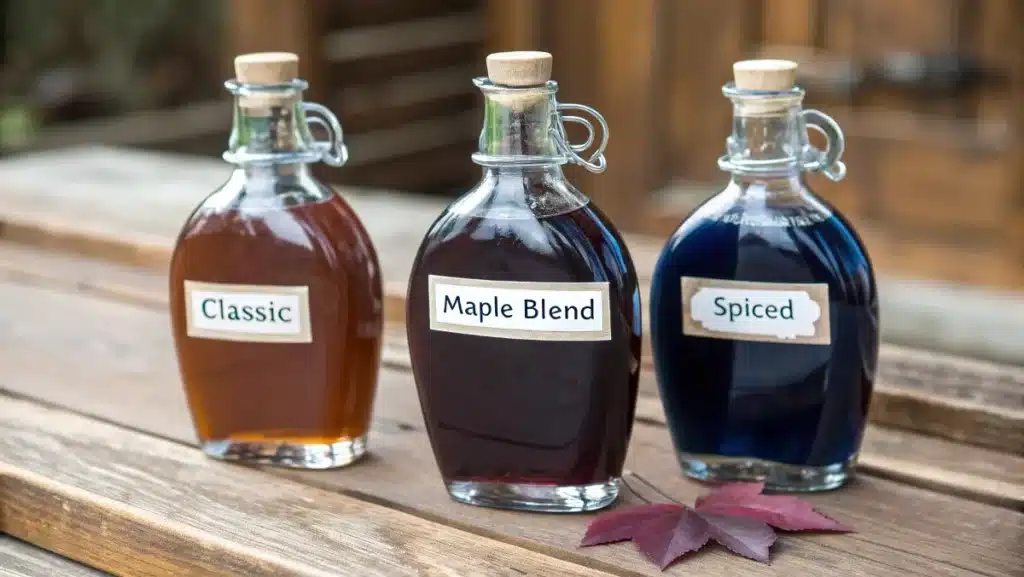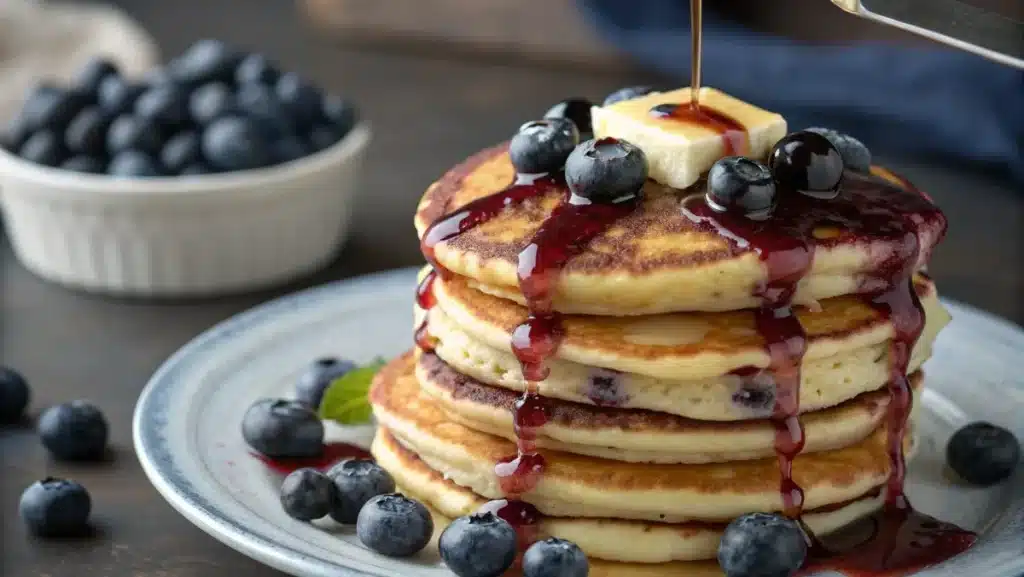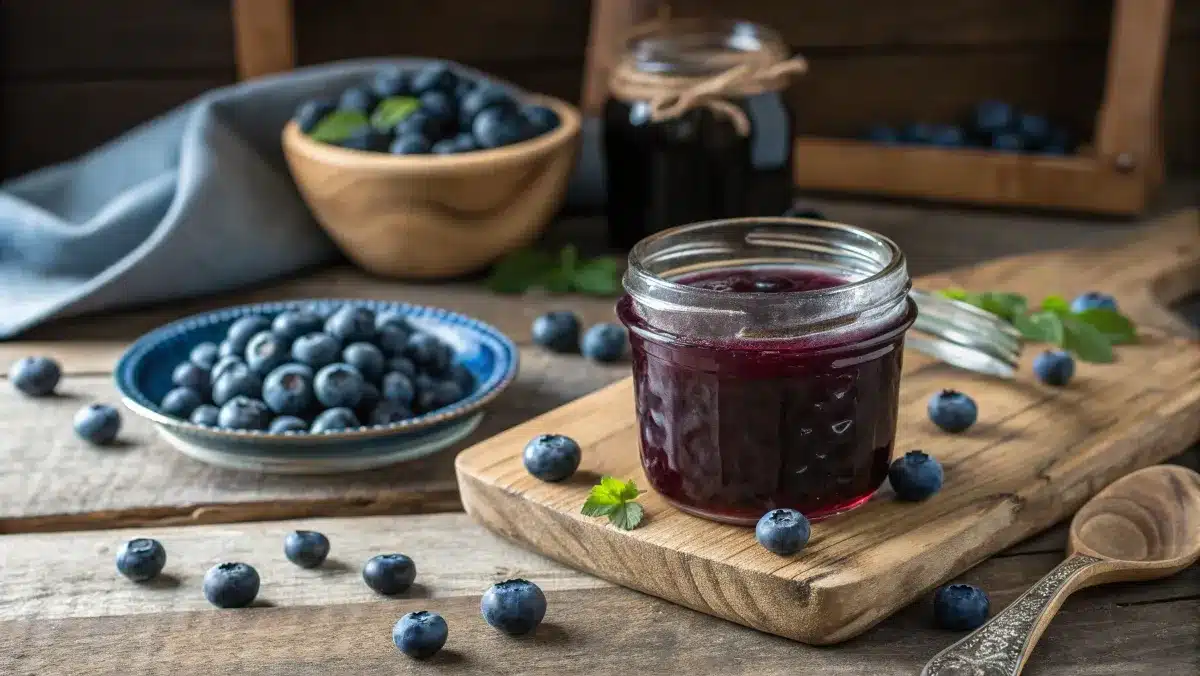Blueberry Syrup Recipe: The Ultimate Guide to Flavorful Homemade Syrup
Blueberry syrup is one of those kitchen treasures that can transform a simple breakfast or dessert into something extraordinary. Whether drizzled over warm pancakes, swirled into creamy yogurt, or stirred into a refreshing drink, this syrup brings out the rich, sweet-tart flavor of blueberries in every drop. In this guide, we’ll walk through the best blueberry syrup recipe, explore ingredient tips, storage methods, and even ways to troubleshoot common problems. By the end, you’ll not only know how to make it but also how to elevate it with variations and pairings that keep things exciting. Don’t miss our pancakes recipe for the perfect dish to pair with your homemade syrup.
Table of Contents
Introduction to Blueberry Syrup
The Timeless Love for Blueberry Syrup
Blueberries have long been celebrated for their vibrant flavor and nutritional punch, and when turned into syrup, they become a versatile kitchen staple. From breakfast tables to gourmet desserts, blueberry syrup has found its way into countless recipes across generations. It’s not just a sweet drizzle—it’s a touch of homemade comfort.
Why Homemade Blueberry Syrup Is Better Than Store-Bought
While store-bought syrups may seem convenient, they often contain high-fructose corn syrup, artificial flavors, and preservatives. A homemade blueberry syrup recipe, on the other hand, gives you control over sweetness, texture, and quality of ingredients. You can decide how thick you want it, whether to strain the berries, and even if you’d like to experiment with spices.
Key Benefits of Making Blueberry Syrup at Home
Homemade syrup is more than just flavorful; it’s also healthier. Blueberries are packed with antioxidants, vitamins, and fiber, and when you make syrup at home, you preserve much of that goodness. Plus, it’s cost-effective—you can whip up a jar of blueberry syrup with just a handful of ingredients, often using blueberries that are already in your freezer.
Ingredients for the Perfect Blueberry Syrup Recipe
Fresh vs. Frozen Blueberries: Which to Choose
When it comes to making a blueberry syrup recipe, both fresh and frozen blueberries work beautifully. Fresh berries bring out a bright, vibrant flavor, especially during peak season, while frozen blueberries are a budget-friendly, year-round option. Since frozen berries are picked at peak ripeness, they retain most of their nutrients and sweetness. If using frozen, no need to thaw—just toss them into the pot.
The Role of Sugar: Best Types to Use
Sugar isn’t just for sweetness; it also helps preserve the syrup and balance the tartness of blueberries. White granulated sugar is the most common choice, offering a clean, sweet taste that doesn’t compete with the fruit. Brown sugar, on the other hand, brings a deeper, molasses-like note that can add richness. For a lighter alternative, you can use coconut sugar or even a blend of natural sweeteners. Discover great ideas like this Lavender Simple Syrup that explores different sweetening options.

Lemon Juice and Zest: Enhancing Natural Blueberry Flavors
A squeeze of fresh lemon juice or a touch of zest brightens the syrup, making the blueberry flavor pop. The acidity balances sweetness, preventing the syrup from becoming cloying. Even a small amount adds complexity and freshness, ensuring your syrup doesn’t taste flat.
Optional Add-ins: Vanilla, Cinnamon, and Spices
For a gourmet twist, consider flavoring your blueberry syrup with a splash of vanilla extract, a cinnamon stick, or even cloves. These subtle additions can transform a basic blueberry syrup recipe into something unique. Spices are especially useful for creating seasonal variations—perfect for holiday brunches or special desserts.
Step-by-Step Blueberry Syrup Recipe
Preparing the Blueberries Properly
Start by rinsing your blueberries thoroughly under cool running water to remove any dirt or residue. If using fresh berries, check for stems and soft spots. Frozen blueberries can go straight into the pot without thawing, but it’s a good idea to break up any clumps for even cooking.
Cooking Process: Simmering for Maximum Flavor
To begin, place your blueberries in a saucepan with sugar and a splash of water. Bring the mixture to a gentle simmer over medium heat. As the berries heat up, they’ll release their juices, creating a rich, fruity base. Stir occasionally to prevent sticking, and gently mash the blueberries with a spoon to help release even more flavor. Don’t miss our Peach Blueberry Cobbler for a similar fruit-cooking technique.
Adjusting Sweetness and Thickness
Once the berries have broken down, taste the mixture. If it’s too tart, add more sugar in small amounts until you reach the desired balance. For a thicker syrup, let it simmer longer to reduce the liquid. If you prefer a lighter consistency, add a splash of water and stir until smooth. The cooking time can vary depending on whether you want a pourable syrup or a thicker sauce-like texture.
Straining vs. Leaving Whole Berries in Syrup
At this stage, you can decide on the final texture of your blueberry syrup recipe. Strain the mixture through a fine-mesh sieve for a silky, seed-free syrup that’s perfect for drinks and elegant desserts. If you enjoy texture, leave the softened berries in for a rustic, jam-like finish that’s ideal for pancakes and waffles. Either way, you’ll have a rich, flavorful syrup ready to use immediately.
Variations of Blueberry Syrup Recipe
Classic Blueberry Syrup
The simplest version uses just blueberries, sugar, and lemon juice. This timeless blueberry syrup recipe balances sweet and tart flavors perfectly, making it an all-around favorite for pancakes, waffles, and even ice cream.
Sugar-Free or Low-Sugar Blueberry Syrup
For those cutting back on sugar, consider using a natural sweetener like stevia, monk fruit, or erythritol. These options give you the sweetness without the calories or glycemic spike. You may need to experiment a bit since some substitutes are sweeter than sugar and require smaller amounts.
Blueberry Maple Syrup Blend
For a rich, earthy twist, combine blueberries with real maple syrup. This variation cuts down on refined sugar while adding depth and complexity to the flavor. It’s an excellent choice for weekend brunches when you want something indulgent. Learn more about the best syrup substitute if you run out of the real thing but still want that maple flavor.

Spiced Blueberry Syrup with Cinnamon or Cloves
Adding warming spices like cinnamon sticks, nutmeg, or cloves transforms your syrup into a cozy, aromatic topping. This variation is especially popular during the holidays, making it a festive drizzle for desserts, cakes, or even hot drinks. A small pinch of spice goes a long way, so start light and adjust to taste.
How to Use Blueberry Syrup in Everyday Dishes
Breakfast Classics: Pancakes, Waffles, and French Toast
There’s nothing quite like starting your morning with a stack of fluffy pancakes or golden waffles topped with blueberry syrup. The sweet-tart burst of flavor pairs beautifully with butter and whipped cream. French toast also shines when drizzled with this homemade syrup, creating a balanced mix of crispy edges and juicy fruit flavor.
Desserts and Ice Cream Pairings
Homemade blueberry syrup makes an excellent topping for vanilla, chocolate, or cheesecake-flavored ice cream. You can also drizzle it over cakes, brownies, or fruit tarts for an added touch of sweetness. Looking for inspiration? Try these ice cream ideas that pair beautifully with blueberry syrup.
Beverages: Cocktails, Mocktails, and Lemonades
Blueberry syrup isn’t just for solid foods—it’s a game-changer in drinks. Stir it into sparkling water for a refreshing soda alternative, mix it with lemonade for a fruity twist, or shake it into cocktails like mojitos and martinis. Non-alcoholic mocktails also benefit from a spoonful of syrup, giving them color and depth without added complexity.

Savory Pairings: Meat Glazes and Salad Dressings
Believe it or not, blueberry syrup has savory applications too. Brush it onto roasted chicken, pork chops, or grilled salmon for a glossy glaze with a hint of sweetness. You can also whisk it into vinaigrettes, pairing beautifully with spinach salads topped with nuts and cheese.
Storing and Preserving Blueberry Syrup
How Long Blueberry Syrup Lasts in the Fridge
Once prepared, blueberry syrup can be stored in an airtight glass jar or bottle in the refrigerator for up to 2 weeks. Make sure the container is sterilized and sealed properly to maximize freshness. Over time, the syrup may thicken slightly, but a quick stir or gentle warming will bring it back to the right consistency.
Freezing Blueberry Syrup for Longer Storage
If you want to extend its shelf life, freezing is a smart option. Pour the cooled syrup into freezer-safe containers or ice cube trays. Once frozen, transfer the cubes into a resealable bag for easy, portioned use. Frozen blueberry syrup lasts up to 3 months and can be thawed in the fridge overnight.
Canning Blueberry Syrup for Extended Use
For those who enjoy canning, blueberry syrup can be preserved using the water-bath canning method. This process ensures your syrup stays shelf-stable for up to a year. It’s ideal if you want to stock your pantry with homemade syrups or give them as gifts. Always follow safe canning guidelines to prevent spoilage.
Signs of Spoilage to Watch For
Even with proper storage, blueberry syrup won’t last forever. Signs of spoilage include off smells, mold, or a cloudy appearance. If in doubt, it’s better to discard and make a fresh batch. Remember, food safety should always come first. Don’t miss our summer fruit desserts for more ways to use up seasonal fruits before they spoil.
Nutritional Benefits of Blueberry Syrup
Antioxidants in Blueberries
Blueberries are often called a “superfood” because they’re loaded with antioxidants, particularly anthocyanins. These compounds give blueberries their deep color and help fight free radicals in the body. Even when cooked into syrup, some of these antioxidants remain, making a blueberry syrup recipe a healthier option compared to artificial syrups.
Vitamins and Minerals in Blueberry Syrup
A serving of homemade syrup retains small amounts of essential nutrients found in blueberries, including vitamin C, vitamin K, and manganese. Vitamin C supports immune function, while manganese aids in bone health and metabolism. Though syrup isn’t a replacement for fresh fruit, it’s still a delicious way to sneak in added nutrients.
Comparing Sugar Content with Store-Bought Syrups
Homemade blueberry syrup allows you to control the level and type of sugar used, unlike store-bought brands that often include high-fructose corn syrup and preservatives. By adjusting sweetness to your taste, you can reduce overall sugar intake without sacrificing flavor. Check out our healthy breakfast ideas for more nutritious ways to start your day with fruit-based toppings.
Moderation: Enjoying Blueberry Syrup the Healthy Way
While blueberry syrup offers nutritional benefits, it’s still best enjoyed in moderation. Pair it with protein-rich foods like Greek yogurt or cottage cheese to balance blood sugar levels. This way, you get both the health perks of blueberries and a more satisfying meal.
Troubleshooting Common Problems with Blueberry Syrup
Syrup Too Thin or Too Thick
One of the most common issues is syrup consistency. If your blueberry syrup turns out too thin, simmer it a little longer to reduce the liquid and concentrate the flavors. On the other hand, if it becomes too thick, simply stir in a few tablespoons of warm water until you reach the desired texture.
Overly Sweet or Too Tart Flavor
Taste preferences vary, and sometimes your syrup may end up too sweet or overly tart. If it’s too sweet, balance it with extra lemon juice or a pinch of salt. If it’s too tart, stir in a bit more sugar or honey. Remember, adjustments are best made gradually so you don’t overcorrect.
Preventing Syrup from Crystallizing
Crystallization occurs when sugar molecules clump together, leaving a gritty texture. To avoid this, make sure the sugar fully dissolves during cooking. Adding a teaspoon of corn syrup or a dash of lemon juice can also help stabilize the mixture and prevent crystallization.
How to Fix Cloudy Syrup
Sometimes homemade blueberry syrup can look cloudy instead of clear and glossy. This usually happens if the fruit pulp isn’t strained thoroughly. To fix it, strain the syrup through a fine-mesh sieve or cheesecloth, pressing gently to extract liquid while leaving solids behind. For a rustic style, however, leaving pulp is completely fine.
Conclusion
Homemade blueberry syrup is one of those kitchen treasures that transforms everyday meals into something extraordinary. From pancakes and waffles to cocktails and savory glazes, this simple syrup recipe adds a burst of flavor and versatility to your cooking. By experimenting with variations, learning how to store it properly, and troubleshooting common problems, you’ll always have a reliable and delicious topping at hand. Whether you’re after a classic recipe, a low-sugar option, or a spiced holiday version, making your own blueberry syrup ensures freshness, control, and flavor that store-bought bottles just can’t match. Don’t miss our How to Make Heavenly Lavender Simple Syrup for even more inspiration.
FAQs
How do you make blueberry syrup?
To make blueberry syrup, combine fresh or frozen blueberries with sugar, water, and lemon juice in a saucepan. Simmer until the berries break down, then strain for a smooth finish or leave the fruit in for extra texture. This basic blueberry syrup recipe takes about 15–20 minutes and requires just a few ingredients.
What enhances the flavor of blueberries?
Blueberries pair beautifully with lemon juice, cinnamon, vanilla extract, and even a splash of maple syrup. These additions enhance their natural sweetness and balance out tartness. A pinch of salt can also bring out more depth in your blueberry syrup recipe without overpowering the fruit.
How long will blueberry syrup last in the fridge?
Homemade blueberry syrup typically lasts up to 2 weeks in the fridge when stored in an airtight container. Always refrigerate after cooling and check for spoilage signs like mold, off smells, or discoloration before using again.
What is the formula for simple syrup?
The basic formula for simple syrup is 1 part sugar to 1 part water, heated until the sugar dissolves. For fruit syrups like blueberry, fruit is simmered along with sugar and water to infuse flavor into the syrup base.
What is the best sugar for simple syrup?
Granulated white sugar is most commonly used because it dissolves easily and has a neutral flavor. However, cane sugar, brown sugar, and even honey can be used to give your blueberry syrup recipe a richer or more complex taste.
How long does homemade simple syrup last?
Plain simple syrup lasts about 1 month in the fridge if stored in a clean, sealed jar. Fruit-based syrups like blueberry usually last 1–2 weeks due to the natural fruit content, though freezing can extend their shelf life up to 3 months.

